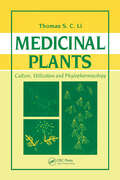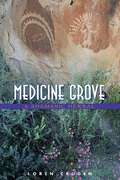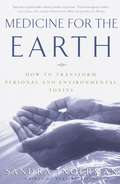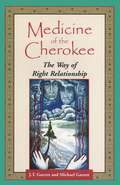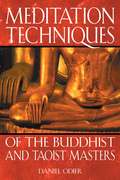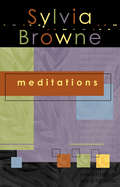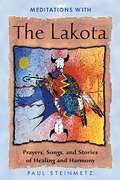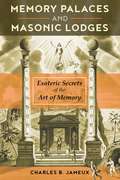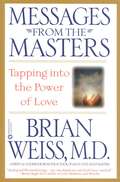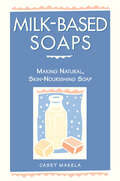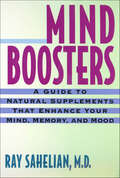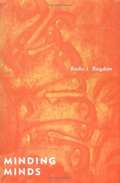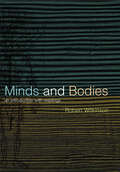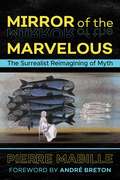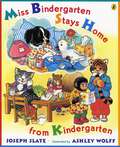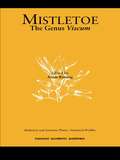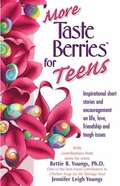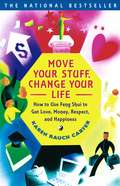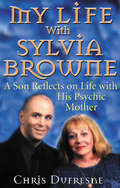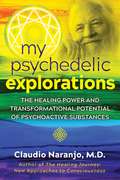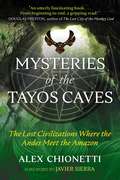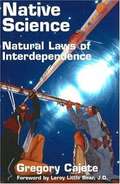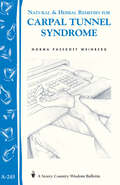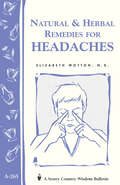- Table View
- List View
Medicinal Plants: Culture, Utilization and Phytopharmacology
by Thomas S. LiMedicinal Plants: Culture, Utilization and Phytopharmacology covers over 400 species. Each chapter gathers valuable information from a wide variety of sources, and supplies it to the user in convenient table format, arranged alphabetically by scientific name, followed by the common name. Data topics include: major constituents (active ingredients)
Medicine Grove: A Shamanic Herbal
by Loren CrudenMedicine Grove is a comprehensive herbal, with listings for every common herb and many wild plants of North America. It includes descriptions of the part of the plant used, notes on preparation, lists of symptoms alleviated by the herb, and common effects. But Medicine Grove goes further, with chapters on gathering and growing wild herbs, using herbs in shamanic ceremonies or as plant allies in the wilderness, and birth, death, and dreaming herbs. Cruden combines her own first-hand experiences with a profound knowledge of indigenous traditions, enabling the reader to bring herbal lore into his or her own practice. She explains which herbs are best for seasonal ceremonies, smudging, and making offerings, and tells how to purify a sacred space. She covers topics such as vision quests, consciousness-altering, and the special connections between certain herbs and totem animals.Medicine Grove brings the concept of an herbal into sacred territory, offering guidelines for incorporating herbs into one's spiritual life, based on the author's lifetime of work with Native American practices.
Medicine for the Earth: How to Transform Personal and Environmental Toxins
by Sandra IngermanFrom cross-cultural legends recounting shamanic cures to the biblical accounts of the parting of the Red Sea and Jesus multiplying the loaves and fishes, many spiritual traditions are rich in stories about seemingly inexplicable transformations of the natural world. The ancient healing art of transmutation, in which toxic substances are transformed into "safe" substances, is mentioned in all the world's great spiritual traditions, including Hinduism and Taoism. And while many have tapped this body of work to heal the self, it has yet to be used to heal our environment. For twenty years, Sandra Ingerman has studied alternative ways to reverse environmental pollution. In this book, Ingerman takes us on a remarkable journey through the history of transmutation, teaching us how we can use this forgotten technique to change ourselves and our environment. She provides us with creative visualizations, ceremonies, rituals, and chants derived from ancient healing practices that produce miraculous, scientifically proven results. In one dramatic illustration of what can be accomplished when consciousness and awareness fuel our actions, Ingerman describes her own success in transforming the nature of chemically polluted water.
Medicine of the Cherokee: The Way of Right Relationship
by Michael Tlanusta Garrett J. T. GarrettDiscover the holistic experience of human life from the elder teachers of Cherokee Medicine. With stories of the Four Directions and the Universal Circle, these once-secret teachings offer us wisdom on circle gatherings, natural herbs and healing, and ways to reduce stress in our daily lives.
Meditation Techniques of the Buddhist and Taoist Masters
by Daniel OdierA guide to the mental disciplines and visualizations that Masters have used for ages in their quest for illumination. * An insider's view of specific meditation techniques and the steps necessary for a wide variety of * Buddhist and Taoist meditation practices. * By the author of Tantric Quest (15,000 sold) and Desire: The Tantric Path to Awakening. The esoteric practices followed in the quest for divinity generally remain a secret to the world--kept cloistered away for only the most ascetic practitioners. Now Daniel Odier, having immersed himself in the life and spiritual practices of Buddhist and Taoist monasteries throughout India, Nepal, Sri Lanka, Thailand, and Japan, reveals actual teachings passed on by the sages who are living expressions of their tradition. Looking beyond doctrine, dogma, and philosophical treatises that ignore direct experiences of the practice, Odier provides a direct path to the heart of the religious experience that can be discovered through meditation. Beginning with the simple and fundamental steps necessary to prepare for meditation, Odier guides the reader through the specifics of the mental disciplines and visualizations that Buddhist and Taoist masters have used for ages in their quest for illumination. To devote oneself to meditation, in the sense understood by Buddhists and Taoists, is to realize the understanding of how every fiber of our being converges with all creation. Meditation Techniques of the Buddhist and Taoist Masters is a valuable guide to all who are in search of that realization.
Meditations
by Sylvia BrowneIn this beautifully illustrated book, renowned psychic and bestselling author Sylvia Browne brings you a heartfelt meditation for each week of the year. Based on the tenets of her church, the Society of Novus Spiritus, these meditations will serve to inspire you, help you relax, and allow you to see the divine nature that exists within you at all times.
Meditations with the Lakota: Prayers, Songs, and Stories of Healing and Harmony
by Paul Steinmetz• Native American meditations that help the reader find spirit in everyday life. • Intimate meditations offer insight into the symbology of the Lakota religious experience. • Lakota elders present the ancient prayers that weave together psyche and spirit. • New Edition of Meditations with Native Americans. The Lakota, people of the sacred buttes of the Black Hills, hold a rich tradition that connects the world of visible creation to the world of spirit. A century after the battle at Wounded Knee, Lakota elders are beginning to speak their belief that this spirituality is indigenous to every man and woman. By inviting all nations to recognize their interdependence with one another and with the earth, Native Americans can help modern man and woman find a personal relationship with nature and a willingness to view creation as sacred. Many feel that this spirituality is not a luxury but a necessity. From impressions and teachings gathered over decades of living with the Oglala Sioux and participating in their ceremonies, author Paul Steinmetz has compiled a book of provocative meditations centered on creation spirituality. Lakota elders join the author in evoking the essence of the sweat lodge ceremony, the vision quest, yuwipi meetings, and the teachings of Buffalo Calf Woman and the sacred pipe, offering the reader a focus for prayerful intention in finding spirit in everyday life. This insider's view reveals the Lakotas' profound interconnectedness with all matter, a weaving of psyche and spirit that is the call to consciousness so crucial at this time.
Memory Palaces and Masonic Lodges: Esoteric Secrets of the Art of Memory
by Charles B. JameuxReveals how the art of memory is the origin of the Masonic method • Explains the classical techniques of the art of memory, how they were reworked by hermetic thinkers during the Renaissance, and how they contributed to the transformation of operative Freemasonry into speculative Freemasonry • Traces the creation of speculative Freemasonry to 1637, one hundred years earlier than previously thought • Explores how the “memory palaces” created with the art of memory enabled access to universal knowledge as well as represented the Masonic temple in its imaginary state In Antiquity, the art of memory was a mnemonic device that allowed an orator, such as Cicero, to recall all the points he wished to make by associating each of them with an image or architectural element in the site he was speaking. When this art was rediscovered in the Renaissance, hermetic thinkers like Giordano Bruno reworked it into a method that allowed them to acquire knowledge with the creation of “memory palaces.” The elements of these memory palaces were not intended to trigger the memory but would actually transform into talismanic objects with knowledge entirely new to the seeker. In this book, Charles B. Jameux shows that this hermetic reworking of the classical art of memory was no mystery to operative Masons, who grafted it onto their own rituals, catalyzing the transformation of operative Masonry into speculative Masonry. He shows how the hieroglyphic writing used during the Renaissance in the art of memory provided the groundwork for one of the most esoteric elements of masonic practice: the grasp of the realm of image by the letter, where symbols were “buried” within words. Using archival evidence from 17th-century Scotland and earlier, combined with the research of modern scholars such as Frances Yates and David Stevenson, Jameux argues that the creation of speculative Freemasonry can be traced back 100 years earlier than conventional history records--to 1637, when the first recorded use of the Mason’s Word appeared and with it, the first known appearance of the symbolic Temple of Solomon. He follows Giordano Bruno’s visit to the British Isles in the late 16th century and the subsequent activities of the men he met there, showing that Masonic symbolism owes much of its current form to early memory palaces, which represented the Masonic lodge and temple in their fully imaginary states. Revealing the pivotal role of the memory palace and hermetic traditions in early Masonic symbolism, Jameux sheds new light on the Masonic questions asked of each initiate and the spiritual importance of the Temple of Jerusalem to Freemasonry.
Messages from the Masters: Tapping into the Power of Love
by Brian WeissThe true story of a prominent psychiatrist, his young patient, and the past-life therapy that changed both their lives. As a traditional psychotherapist, Dr. Brian Weiss was astonished and skeptical when one of his patients began recalling past-life traumas that seemed to hold the key to her recurring nightmares and anxiety attacks. His skepticism was eroded, however, when she began to channel messages from the "space between lives," which contained remarkable revelations about Dr. Weiss' family and his dead son. Using past-life therapy, he was able to cure the patient and embark on a new, more meaningful phase of his own career.
Milady's Standard Textbook of Cosmetology
by Milady Publishing Company StaffFor over 60 years, Milady's Standard Textbook of Cosmetology has been the textbook of choice for cosmetology education. Used in 48 countries and developed in 5 languages, Milady's Standard is recognized as the undisputed industry leader and primary source of the most current and comprehensive cosmetology education available for cosmetology students. This newly revised edition continues to provide students with the knowledge and skills required to pass state licensing exams and provide professional cosmetology services. Drawing on the input and expertise of many industry leaders, educators, and artists, this revised textbook gives students a thorough understanding of both the theory and practice of all pertinent subjects. And for the very first time, the frontmatter of the textbook includes an overview/definition of the National Skills Standards for Entry Level Cosmetologists, developed by the Cosmetology Advancement Foundation (CAF). ALSO AVAILABLEISBN: 1-56253-467-X (Softcover)Theory Workbook, 2000, ISBN: 1-56253-468-8Practical Workbook, 2000, ISBN: 1-56253-469-6State Exam Review, ISBN: 1-56253-472-6INSTUCTOR SUPPLEMENTS CALL CUSTOMER SUPPORT TO ORDERCourse Management Guide, 2000, ISBN: 1-56253-471-8
Milk-Based Soaps: Making Natural, Skin-Nourishing Soap
by Casey MakelaCraft beautiful, sweet-smelling milk-based soaps safely and easily. In this fun and informative guide, Casey Makela shares her specialized techniques for producing lusciously creamy soaps. With straightforward instructions and thorough explanations, Makela teaches you how to fashion your own soaps from vegetable oils and tallow bases, giving dozens of suggestions for relaxing scents and specialty colors that will let your product shine. You’ll soon be creating enticingly unique soaps that will keep your glowing skin smelling and feeling good all day.
Mind Boosters: A Guide to Natural Supplements That Enhance Your Mind, Memory, and Mood
by Ray SahelianEveryone forgets things sometimes. But do you ever feel like you can't keep track of simple things like acquaintances' names, your car keys, and the two things you needed to pick up on the way home? As America's population ages, more and more people are struggling with the fact that their memory and mental power are not that they used to be. Maybe you've tried "exercising" your mind, or maybe you've just started keeping better "to do" lists. But a proven way to improve your mind, memory and mood is to feed your brain the nutrients it needs to function at its peak performance level. Over the past few years, scientists have discovered dozens of new supplements that enhance and sharpen memory, intelligence, vision, and mental performance. In Mind Boosters, one of the world's most respected nutritional experts examines the very latest research on these breakthrough brain nutrients, amino acids, herbs, and hormones. Along with a scientific and practical evaluation of their benefits and risks, Dr. Sahelian explains how to combine mind-boosting supplements to help patients with Alzheimer's, Parkinson's, depression as well as those with normal age-related mental decline. People of all ages can benefit from the sensible, step-by-step programs tailored to the differing needs of the young, the middle aged and the elderly.
Minding Minds: Evolving a Reflexive Mind by Interpreting Others
by Radu J. BogdanMental reflexivity, or metamentation--a mind thinking about its own thoughts--underpins reflexive consciousness, deliberation, self-evaluation, moral judgment, the ability to think ahead, and much more. Yet relatively little in philosophy or psychology has been written about what metamentation actually is, or about why and how it came about. In this book, Radu Bogdan proposes that humans think reflexively because they interpret each other's minds in social contexts of cooperation, communication, education, politics, and so forth. As naive psychology, interpretation was naturally selected among primates as a battery of practical skills that preceded language and advanced thinking. Metamentation began as interpretation mentally rehearsed: through mental sharing of attitudes and information about items of common interest, interpretation conspired with mental rehearsal to develop metamentation. Drawing on philosophical, psychological, and evolutionary perspectives, Bogdan analyzes the main phylogenetic and ontogenetic stages through which primates' abilities to interpret other minds evolve and gradually create the opportunities and resources for metamentation. Contrary to prevailing views, he concludes that metamentation benefits from, but is not a predetermined outcome of, logical abilities, language, and consciousness.
Minds and Bodies: An Introduction with Readings (Philosophy and the Human Situation)
by Robert WilkinsonMinds and Bodies is a clear introduction to the mind-body problem. It requires no prior philosophical knowledge and is ideally suited to newcomers to philosophy and philosophy of mind. Robert Wilkinson carefully introduces the fundamental components of the philosophy of mind: Descartes's dualist account of mind and body; monist views including eliminativism; computer science and artificial intelligence. Each chapter is linked to a reading from key thinkers in the field, from Descartes to Paul Churchland.
Mirror of the Marvelous: The Surrealist Reimagining of Myth
by André Breton Pierre MabilleA surrealist exploration of the marvelous in ancient, classic, and modern works from around the world • Long considered one of the most significant and original books to have come out of the surrealist movement • Reveals the “marvelous” in works from William Blake, Edgar Allen Poe, William Shakespeare, Chrétien de Troyes, and Arthur Rimbaud; legends and folktales from around the world; classics from Ovid, Plato, and Apuleius; Masonic ritual texts, Mesopotamia’s Epic of Gilgamesh, the Popol-Vuh, Lewis Caroll’s Alice through the Looking Glass, Solomon’s Song of Songs, and Goethe’s Faust First published in French as Miroir du merveilleux in 1940, Mirror of the Marvelous has long been considered one of the most significant and original books to have come out of the surrealist movement and Anaïs Nin suggested it as a source of inspiration, far ahead of its time. Drawing on sacred and modern texts that share a quality of the marvelous, Pierre Mabille defines “the marvelous” as the point at which inner and outer realities are joined and the individual is simultaneously one with himself and with the world, thus recovering the true sense of the sacred. He shows how “the marvelous” goes beyond simply being a synonym for “the fantastic” to engage the entire emotional realm. Mabille cites a far-reaching range of texts, from the classic to the obscure, from Egyptian myth to Voodoo initiation ceremonies, from the ancient epic to the modern poem, from the creation myth to more contemporary visions of apocalypse. He includes surrealist analyses of works from William Blake, Edgar Allen Poe, William Shakespeare, Chrétien de Troyes, and Arthur Rimbaud; legends and folktales from Egypt, Iceland, Mexico, Africa, India, and other cultures; classics from Ovid, Plato, and Apuleius; Masonic ritual texts, Mesopotamia’s Epic of Gilgamesh, the Popol-Vuh, Lewis Caroll’s Alice through the Looking Glass, Solomon’s Song of Songs, and selections from Goethe’s Faust. Mirror of the Marvelous actively defines the flame of the marvelous by showing its presence in those works where it burns the brightest.
Miss Bindergarten Stays Home From Kindergarten (Miss Bindergarten Books Ser.)
by Joseph SlateA playful take on a topic that all parents can relate to-getting sick! The ever-lovable Miss Bindergarten is not feeling well. The flu strikes on Sunday, so she has to stay home from kindergarten on Monday. Mr. Tusky (who is a wee bit rusty) will be her substitute, but it just won't be the same. The kindergartners miss Miss Bindergarten! They pass the time by making get-well cards and singing songs, all the while counting out the days that Miss Bindergarten is away. What ever will they do without her?
Mistletoe: The Genus Viscum (Medicinal And Aromatic Plants Ser. #Vol. 16)
by Arndt BussingThis book provides a comprehensive overview of current knowledge in mistletoe use from well recognised researchers from Argentina, England, Greece, Korea, Switzerland, USA and Germany, and will be an invaluable reference source for anyone with an interest in the wide range of applications of this plant and its therapeutic potential in cancer therap
More Taste Berries for Teens: Inspirational Short Stories and Encouragement on Life, Love, Friendship and Tough Issues
by Bettie B. Youngs Jennifer Leigh Youngs Youngs JenniferLike its best-selling predecessor, this book deftly combines teen contributions and responses with the commentary and sensitive advice of coauthors Bettie B. Youngs, Ph. D. , Ed. D. , and Jennifer Leigh Youngs, showing teens that we each can make life better through our love and compassion. This book will focus on the themes similar to the ones handled in the first volume and the journal, including: self-worth; friendship; love and relationships; parents and teens; how to create an attitude for life success; how to decide what to do in life; how to give, share and make a difference; and how to cope with stress-filled and embarrassing moments. As with the other volumes in this series, teens are sure to find that this book will help them connect with their innermost feelings, identify their fondest dreams and turn them into reality, and, most important, recognize that they are not alone in what they encounter or how they feel. More Taste Berries for Teens is sure to become a treasured companion and trusted guide to all its readers as they journey toward making their lives better and brighter.
Move Your Stuff, Change Your Life: How to Use Feng Shui to Get Love, Money, Respect and Happiness
by Karen Rauch CarterAn essential and accessible guide to increasing happiness, improving your financial well-being, and bettering your health through the timeless Chinese art of feng shui.Promising health, wealth, and happiness, feng shui offers endless appeal—at least in concept. Unfortunately, feng shui&’s seemingly complicated methods are often difficult to learn and apply in a meaningful way. Fortunately, Move Your Stuff, Change Your Life is written in plain and simple English for the modern Western reader. Revealing the ancient Chinese secrets that are as useful and necessary today as they have been for centuries, Move Your Stuff, Change Your Life communicates how to: · MEET &“THE ONE&” · FIND A DREAM JOB · EARN BETTER GRADES IN SCHOOL · ENJOY A BETTER SEX LIFE
My Life With Sylvia Browne: A Son Reflects On Life With His Psychic Mother
by Chris DufresneThis is the highly entertaining and informative story of Chris Dufresne’s life with his incomparable mother from his childhood years to the present day. A respected clairvoyant in his own right, he details the incredible spiritual, emotional, and psychic bond that the two share, revealing the Sylvia Browne that he deeply loves—a passionately loyal and protective mother, grandmother, wife, and friend.
My Psychedelic Explorations: The Healing Power and Transformational Potential of Psychoactive Substances
by Claudio NaranjoClaudio Naranjo&’s psychedelic autobiography with previously unpublished interviews and research papers • Explores Dr. Naranjo&’s pioneering work with MDMA, ayahuasca, cannabis, iboga, and psilocybin • Shares his personal accounts of psychedelic sessions and experimentation, including his work with Alexander &“Sasha&” Shulgin and Leo Zeff • Includes the author&’s reflections on the spiritual aspects of psychedelics and his recommended techniques for controlled induction of altered states In the time of the psychedelic pioneers, there were psychopharmacologists like Alexander &“Sasha&” Shulgin, psychonauts like Aldous Huxley, and psychiatrists like Humphrey Osmond. Claudio Naranjo was all three at once. He was the first to study the psychotherapeutic applications of ayahuasca, the first to publish on the effects of ibogaine, and a long-time collaborator with Sasha Shulgin in the research behind Shulgin&’s famous books. A Fulbright scholar and Guggenheim fellow, he worked with Leo Zeff on LSD-assisted therapy and Fritz Perls on Gestalt therapy. He was a presenter at the 1967 University of California LSD Conference and, 47 years later, gave the inaugural speech at the First International Conference on Ayahuasca in 2014. Across his career, Dr. Naranjo gathered more clinical experience in individual and group psychedelic treatment than any other psychotherapist to date. In this book, his final work, Dr. Naranjo shares his psychedelic autobiography along with previously unpublished interviews, session accounts, and research papers on the therapeutic effects of psychedelics, including MDMA, ayahuasca, cannabis, iboga, and psilocybin. The book includes Naranjo&’s reflections on the spiritual aspects of psychedelics and the healing transformations they bring, his philosophical explorations of how psychedelics act as agents of deeper consciousness, and his recommended techniques for controlled induction of altered states using different visionary substances. Naranjo&’s work shows that psychedelics have the strongest potential for transforming and healing people over all therapeutic methods currently in use.
Mysteries of the Tayos Caves: The Lost Civilizations Where the Andes Meet the Amazon
by Alex ChionettiA detailed examination of the controversial expeditions to the Tayos Cave complex in Ecuador and the treasures glimpsed in its depths • Reconstructs the expeditions from the 1960s and &’70s, including the Mormon Church&’s search for lost tablets, Stanley Hall&’s quest with Neil Armstrong, and sightings of a metal library, books of gold, copper plates, and a quartz sarcophagus • Includes photos from the author&’s own dangerous expeditions to the Tayos Caves • Explores connections to Atlantis, Ancient Astronauts, and the Hollow Earth theory and the possibility of tunnel networks that extend from the Rocky Mountains to Patagonia The Cuevas de los Tayos is a cavern complex in the Amazon rain forest of Ecuador. Named for the tayos, the oil birds that reside within them, these caves have countless enigmas connected with them, from the discovery of inexplicable architectural details, to claims of curses and treasures, to dangerous encounters with the indigenous people, the Shuar, for whom the caves are sacred. Sharing his more than 30 years of research into the Tayos Caves as well as his own explorations, Alex Chionetti examines the legends and mysteries associated with this site and the explorers who have ventured within. He details the discovery of the Tayos Cave complex by Hungarian explorer Janos Juan Moricz in the 1960s, including Moricz&’s claims of finding a metal library with books of gold. Exploring the oral tradition of the Shuar, he explains how this region was the possible origin of Incan culture and the legend of El Dorado. The author shares his own dangerous explorations within the Tayos Caves, and, drawing on unpublished interviews with speleologist Julio Goyén Aguado, he reconstructs the expeditions of the 1960s and &’70s, revealing the Mormon Church&’s search for lost tablets, a British army incursion, and sightings of paintings, gold statues and skeletons, copper plates, and a quartz sarcophagus--treasures akin to the Crespi treasure. The author also shares details from Stanley Hall&’s suspicious expedition in 1976, which included astronaut Neil Armstrong. Investigating the lost civilizations behind the Tayos treasures, Chionetti explores the possible connections to Atlantis, aliens, Ancient Astronauts, and the Hollow Earth theory; the caves&’ links with hermetic societies; and claims of tunnel networks that extend thousands of miles through both American continents, from the Rocky Mountains to Patagonia. Sharing a real-life adventure story wilder than an Indiana Jones plot, the author shows that Earth&’s ancient past has many secrets waiting to be uncovered.
Native Science: Natural Laws of Interdependence
by Gregory CajeteCajete examines the multiple levels of meaning that inform Native astronomy, cosmology, psychology, agriculture, and the healing arts. Unlike the western scientific method, native thinking does not isolate an object or phenomenon in order to understand it, but perceives it in terms of relationship. An understanding of the relationships that bind together natural forces and all forms of life has been fundamental to the ability of indigenous peoples to live for millennia in spiritual and physical harmony with the land. It is clear that the first peoples offer perspectives that can help us work toward solutions at this time of global environmental crisis.
Natural & Herbal Remedies for Carpal Tunnel Syndrome: Storey Country Wisdom Bulletin A-245 (Storey Country Wisdom Bulletin Ser.)
by Norma Pasekoff WeinbergDo you have: Recurrent numbness, pain, or tingling in your fingers, wrist, or hand? Does it persist at night? Can it be "shaken" out?A sense of weakness in your hand?Loss of feeling of heat or cold in your hand?If you answered yes to these questions, you may be suffering from carpal tunnel syndrome. If not detected and treated, this common condition can quickly become disabling. Once the diagnosis is in, the first treatment recommended is often surgery. However, such extreme measures aren't always necessary. In Natural & Herbal Remedies for Carpal Tunnel Syndrome, Norma Pasekoff Weinberg offers strengthening hand exercises, gentle stretches, and herbal recipes that ease pain and encourage the body to heal itself. With attention to ergonomics and these simple remedies, most cases of carpal tunnel syndrome can be resolved -- or even avoided -- naturally and effectively.
Natural & Herbal Remedies for Headaches: Storey's Country Wisdom Bulletin A-265 (Storey Country Wisdom Bulletin Ser.)
by Elizabeth Wotton N.D.Headaches, which range from mere annoyance to debilitating pain, are the most common health complaint in North America. Over-the-counter medications offer only temporary relief, and prescription drugs can cause serious side effects. Wouldn't you love to know how to treat - and prevent - your headaches effectively, safely, and naturally? In Natural & Herbal Remedies for Headaches, Elizabeth Wotton, a licensed naturopathic physician, explains the nature of headaches and offers all-natural preventives and treatments. She'll teach you how to: Figure out what kind of headache you're havingIdentify what's triggering your headachesSupplement your diet with headache-fighting nutrientsUse soothing herbal teas, tinctures, and baths to feel better fastBanish headaches from your life!
